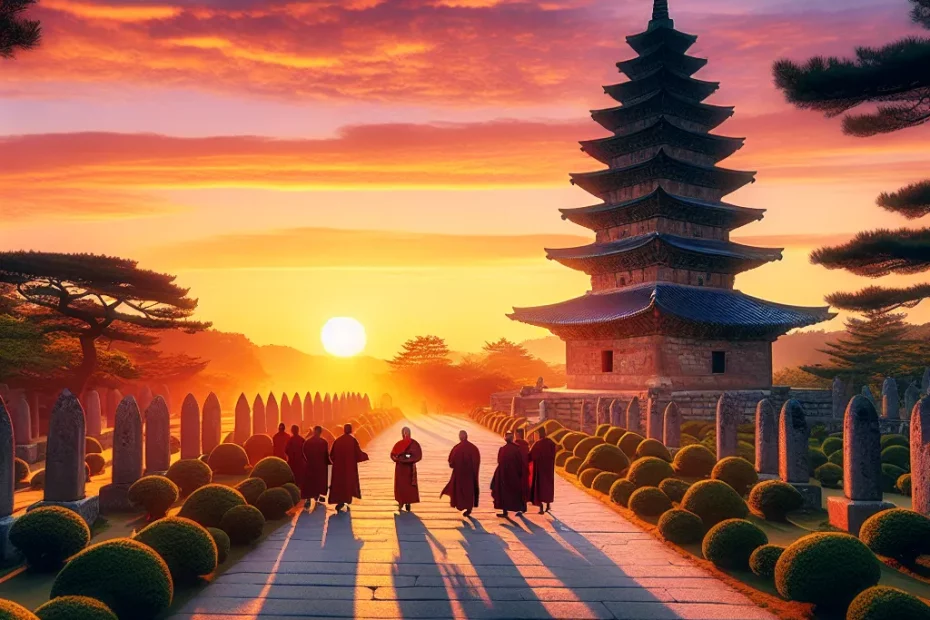Bulguksa Temple, a UNESCO World Heritage Site, stands as a testament to Korea’s rich cultural and architectural heritage. Its intricate design and historical significance make it a must-visit destination for history enthusiasts and travelers alike. As we delve into the history and architectural features of Bulguksa Temple, we uncover a treasure trove of stories and craftsmanship that have withstood the test of time. Join me on a journey through the ages as we explore the profound impact and legacy of this iconic temple.

Overview of Bulguksa Temple
Architectural Marvel:
Bulguksa Temple showcases the finest examples of traditional Korean Buddhist architecture. The temple complex consists of various halls, pagodas, and bridges, all meticulously designed and constructed to harmonize with the surrounding natural landscape. The Dabotap and Seokgatap pagodas, in particular, are exquisite examples of Silla-era stone pagodas, symbolizing the ancient craftsmanship and artistic achievements of the time.
Scenic Beauty:
Nestled on the slopes of Mount Toham, Bulguksa Temple is surrounded by lush forests and serene gardens, creating a peaceful and tranquil atmosphere for visitors. The temple’s location offers breathtaking views of the surrounding mountains and valleys, making it a perfect place for meditation and contemplation.
Spiritual Significance:
As a center of Buddhist practice and worship, Bulguksa Temple holds deep spiritual significance for practitioners and visitors alike. The temple complex houses numerous relics, statues, and scriptures that reflect the rich Buddhist heritage of Korea. The Daeungjeon Hall, the main hall of the temple, enshrines a statue of the Buddha, providing a sacred space for prayer and reflection.
Cultural Heritage:
Beyond its architectural and spiritual significance, Bulguksa Temple is a living testament to Korea’s cultural heritage and identity. The temple complex has survived centuries of wars, invasions, and natural disasters, standing as a symbol of resilience and cultural pride. Each year, the temple hosts traditional ceremonies and events that showcase Korea’s vibrant cultural traditions to visitors.
Tourist Attraction:
Today, Bulguksa Temple is not only a place of worship but also a popular tourist destination in South Korea. Visitors can explore the various halls, pavilions, and courtyards of the temple complex, immersing themselves in the beauty and history of this ancient site. The temple’s serene surroundings and historical significance make it a must-visit destination for anyone interested in Korean culture and history.
In conclusion, Bulguksa Temple stands as a testament to Korea’s rich cultural heritage and spiritual legacy. With its stunning architecture, scenic beauty, and deep spiritual significance, this UNESCO World Heritage Site continues to inspire and awe visitors from around the world. Plan your visit to Bulguksa Temple and experience the magic of this ancient treasure for yourself!
History and Origins of Bulguksa Temple
Located in Gyeongju, South Korea, Bulguksa Temple is a significant cultural and historical site with deep roots in Korean Buddhism. The temple, which means “Temple of the Buddha Land,” was first constructed in the 8th century during the Silla Dynasty. 🏯
Construction and Purpose
Bulguksa Temple was built under the direction of Prime Minister Kim Daeseong and the Silla royal court. The temple was designed to enshrine important relics of the Buddha and serve as a center for Buddhist practice and education. 🌟
Architecture and Design
The layout and architecture of Bulguksa Temple are a prime example of traditional Korean Buddhist temple design. The temple complex consists of various halls, pagodas, and bridges, all meticulously planned to create a harmonious and spiritually uplifting environment. 🌸
Iconic Features
One of the most iconic features of Bulguksa Temple is the Dabotap Pagoda, a stone pagoda that stands as a symbol of harmony and balance in Buddhist teachings. The intricate carvings and detailed craftsmanship of the pagoda showcase the skill and artistry of the Silla artisans. 🌿
Throughout its long history, Bulguksa Temple has undergone several renovations and restorations to preserve its cultural significance. In 1995, the temple was designated as a UNESCO World Heritage Site, recognizing its outstanding universal value and contribution to world heritage. 🌏
Today, Bulguksa Temple remains an active center of Buddhist practice and a popular destination for tourists and pilgrims seeking spiritual enlightenment and cultural enrichment. The temple’s rich history and serene beauty continue to captivate visitors from around the world, making it a must-visit site for anyone interested in Korean history and Buddhist culture. 🙏
In conclusion, Bulguksa Temple stands as a testament to the enduring legacy of Korean Buddhism and the cultural achievements of the Silla Dynasty. Its historical significance, architectural beauty, and spiritual importance make it a truly remarkable site that deserves its place as a UNESCO World Heritage Site. 🌟
Architectural Features of Bulguksa Temple
Situated in Gyeongju, South Korea, Bulguksa Temple stands as a testament to ancient Korean architecture and Buddhist artistry. This UNESCO World Heritage Site showcases a harmonious blend of intricate design elements, symbolic structures, and spiritual significance. Let’s delve into the architectural features that make Bulguksa Temple a masterpiece of Korean heritage! 🏯🌟
Dabotap and Seokgatap Pagodas
One of the most striking features of Bulguksa Temple is its Dabotap and Seokgatap Pagodas, which symbolize balance and harmony in the universe. The Dabotap Pagoda, standing at 10.4 meters, represents the land, while the Seokgatap Pagoda, at 8.2 meters, symbolizes the world of Buddha. These pagodas are adorned with exquisite carvings and intricate details, reflecting the skilled craftsmanship of the Silla Dynasty artisans. 🌸✨
Main Hall – Daeungjeon
The temple’s main hall, Daeungjeon, is a prime example of traditional Korean architecture. With its elegant wooden structure, curved roof, and colorful paintings, Daeungjeon exudes a sense of serenity and reverence. The hall houses the golden Buddha statue of Vairocana, the Cosmic Buddha, surrounded by Bodhisattvas and guardians, creating a sacred space for prayer and meditation. 🙏🎨
Cheongungyo and Baegungyo Bridges
As you wander through the temple grounds, you’ll encounter the Cheongungyo and Baegungyo bridges, which symbolize the transition from the secular to the sacred. Crossing these bridges signifies entering a realm of spiritual enlightenment and leaving behind worldly distractions. The intricate design of the bridges, with their stone pillars and arched pathways, adds a sense of grandeur to the temple complex. 🌉🌿
Layout and Design
Bulguksa Temple’s unique layout, with its multiple halls, pagodas, and pavilions, reflects the principles of Buddhist cosmology and the pursuit of enlightenment. Each building is carefully positioned to align with the surrounding natural landscape, creating a sense of harmony between man-made structures and the environment. The temple’s design emphasizes balance, symmetry, and spiritual symbolism, inviting visitors to contemplate the interconnectedness of all things. 🌏🕊️
In conclusion, the architectural features of Bulguksa Temple offer a glimpse into the rich cultural heritage of Korea and the profound spiritual beliefs of its people. From the towering pagodas to the intricate carvings, every detail of the temple tells a story of devotion, craftsmanship, and artistic excellence. Visiting Bulguksa Temple is not just a journey through history; it’s a spiritual experience that connects us to the wisdom of the past and the beauty of the present. 🌟🙌
Experience the awe-inspiring beauty of Bulguksa Temple and immerse yourself in the timeless elegance of Korean Buddhist architecture. 🌺🏛️
Significance of Bulguksa Temple as a UNESCO World Heritage Site
Nestled in the heart of South Korea, Bulguksa Temple stands as a testament to the rich cultural heritage and historical significance of the region. Designated as a UNESCO World Heritage Site in 1995, this ancient temple complex holds immense value not only for its architectural beauty but also for its profound spiritual and historical importance. 🏯✨
The Architectural Masterpiece
With a history dating back to the 8th century, Bulguksa Temple is a masterpiece of ancient Korean architecture, showcasing the exquisite craftsmanship and attention to detail of the Silla Dynasty. The temple complex consists of numerous halls, pagodas, and bridges, each intricately designed to harmonize with the natural surroundings and create a sense of tranquility and serenity. 🌿🌸
Symbols of Balance and Harmony
One of the most striking features of Bulguksa Temple is the Dabotap and Seokgatap pagodas, which symbolize the ideals of balance and harmony in Buddhist philosophy. These pagodas, along with the main hall Daeungjeon, are considered masterpieces of Korean Buddhist art and architecture, attracting visitors from around the world to marvel at their beauty and significance. 🏛️🌏
Spiritual Significance
Beyond its architectural splendor, Bulguksa Temple holds deep spiritual significance as a center of Buddhist practice and worship. The temple complex houses several important relics and artifacts, including stone lanterns, pagodas, and statues, each carrying its own symbolic meaning and historical importance. For centuries, Bulguksa Temple has served as a place of pilgrimage and meditation, drawing believers and seekers alike to experience its sacred atmosphere and seek enlightenment. 🙏🌟
Preservation of Cultural Heritage
As a UNESCO World Heritage Site, Bulguksa Temple plays a crucial role in preserving and promoting Korean cultural heritage on the global stage. Its inclusion on the prestigious list recognizes the temple’s outstanding universal value and highlights its contribution to the cultural diversity of humanity. By safeguarding and showcasing Bulguksa Temple, South Korea not only honors its past but also ensures that future generations can appreciate and learn from this invaluable cultural legacy. 🌐🌺
In conclusion, the significance of Bulguksa Temple as a UNESCO World Heritage Site cannot be overstated. From its architectural grandeur to its spiritual depth, this ancient temple complex embodies the essence of Korean culture and history, serving as a symbol of resilience, beauty, and wisdom for all who visit. 🌟🌿 Let us continue to cherish and protect this cultural treasure for generations to come! 🙌🏯
Bulguksa Temple stands as a testament to Korea’s rich cultural heritage, with its intricate architectural features and historical significance. As a UNESCO World Heritage Site, it serves as a symbol of the country’s enduring spiritual traditions and artistic achievements. The temple’s history and origins reflect a deep connection to Buddhism and the enduring legacy of ancient Korean dynasties. Its preservation is not just a matter of historical importance, but a commitment to safeguarding a valuable piece of global heritage. The architectural beauty of Bulguksa Temple is a marvel in itself, showcasing the skill and craftsmanship of ancient artisans. Visiting this site is not just a journey through time, but a profound experience that allows one to appreciate the artistry and spirituality of Korea’s past. In essence, Bulguksa Temple is more than just a collection of buildings; it is a living testament to the cultural richness and historical depth of Korea.
